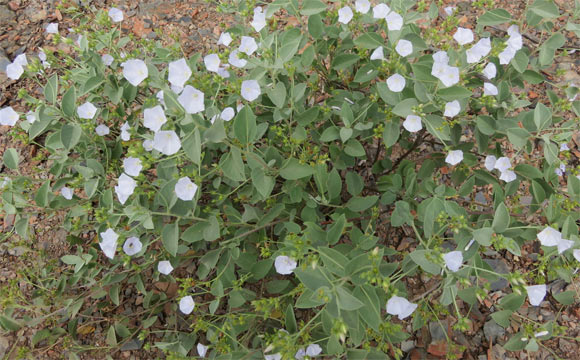Five New Species of Flowering Plants Discovered in Bolivia
Jul 23, 2021 by News Staff / Source
A team of U.K. botanists has discovered five new species in the plant genus Jacquemontia in the Andes of Bolivia.

Jaquemontia chuquisacensis. Image credit: John Pink.
Jacquemontia is a medium-sized pantropical genus of around 120 species, but the majority of species are Neotropical, the greatest diversity being in Brazil.
Most species in the genus are modest, twining or trailing species with pretty blue flowers.
Commonly known as clustervine, they often grow in open, bushy or grassy habitats.
Some species are highly specialized, growing even on bare rock with very little soil or water, while some require fire to stimulate seed germination.
Most species flower during and just after the end of the rainy season so the best time to find species of Jacquemontia in flower is in the February-June period.
“Many plant species have not been identified and classified, especially in the tropics,” said Dr. Rosemary Clegg, a botanist at the University of Exeter and the Royal Botanic Gardens, Kew.
“If you don’t know what a species is, you can’t conserve it.”
“Working with local collaborators in Bolivia, we’ve identified five new Jacquemontia species — and our work so far suggests most of them are relatively rare.”
The five new Jacquemontia species are named: Jacquemontia boliviana, Jacquemontia cuspidata, Jacquemontia longipedunculata, Jacquemontia mairae, and Jaquemontia chuquisacensis.
“We’ve classified and described 28 Jacquemontia species now known to live in Bolivia and Peru,” said Dr. Clegg and her colleague, Dr. John Wood from the University of Oxford and the Royal Botanic Gardens, Kew.
“Although Peru and Bolivia are neighbors and have several species in common, their Jacquemontia flora is rather different.”
“In Bolivia, the east is the most diverse in terms of species numbers although country endemics are entirely Andean. In Peru, the greatest diversity and endemism are in the dry north near the Ecuador border.”
“We now want to discover more about the new species, and where each can be found as — at present — some are only known to exist in a single location,” they said.
“Plants limited to a small area are highly vulnerable to threats such as the arrival of invasive species and habitat destruction for agriculture, mining and road and reservoir construction.”
The team’s paper was published in the journal Kew Bulletin.
_____
J.R.I. Wood & R. Clegg. Jacquemontia (Convolvulaceae) in Bolivia and Peru. Kew Bull, published online July 22, 2021; doi: 10.1007/s12225-021-09936-5
http://www.sci-news.com/biology/five-new-jacquemontia-species-bolivia-09893.html?utm_source=feedburner&utm_medium=email&utm_campaign=Feed%3A+BreakingScienceNews+%28Breaking+Science+News%29
Thanks to: http://www.sci-news.com
Jul 23, 2021 by News Staff / Source
A team of U.K. botanists has discovered five new species in the plant genus Jacquemontia in the Andes of Bolivia.

Jaquemontia chuquisacensis. Image credit: John Pink.
Jacquemontia is a medium-sized pantropical genus of around 120 species, but the majority of species are Neotropical, the greatest diversity being in Brazil.
Most species in the genus are modest, twining or trailing species with pretty blue flowers.
Commonly known as clustervine, they often grow in open, bushy or grassy habitats.
Some species are highly specialized, growing even on bare rock with very little soil or water, while some require fire to stimulate seed germination.
Most species flower during and just after the end of the rainy season so the best time to find species of Jacquemontia in flower is in the February-June period.
“Many plant species have not been identified and classified, especially in the tropics,” said Dr. Rosemary Clegg, a botanist at the University of Exeter and the Royal Botanic Gardens, Kew.
“If you don’t know what a species is, you can’t conserve it.”
“Working with local collaborators in Bolivia, we’ve identified five new Jacquemontia species — and our work so far suggests most of them are relatively rare.”
The five new Jacquemontia species are named: Jacquemontia boliviana, Jacquemontia cuspidata, Jacquemontia longipedunculata, Jacquemontia mairae, and Jaquemontia chuquisacensis.
“We’ve classified and described 28 Jacquemontia species now known to live in Bolivia and Peru,” said Dr. Clegg and her colleague, Dr. John Wood from the University of Oxford and the Royal Botanic Gardens, Kew.
“Although Peru and Bolivia are neighbors and have several species in common, their Jacquemontia flora is rather different.”
“In Bolivia, the east is the most diverse in terms of species numbers although country endemics are entirely Andean. In Peru, the greatest diversity and endemism are in the dry north near the Ecuador border.”
“We now want to discover more about the new species, and where each can be found as — at present — some are only known to exist in a single location,” they said.
“Plants limited to a small area are highly vulnerable to threats such as the arrival of invasive species and habitat destruction for agriculture, mining and road and reservoir construction.”
The team’s paper was published in the journal Kew Bulletin.
_____
J.R.I. Wood & R. Clegg. Jacquemontia (Convolvulaceae) in Bolivia and Peru. Kew Bull, published online July 22, 2021; doi: 10.1007/s12225-021-09936-5
http://www.sci-news.com/biology/five-new-jacquemontia-species-bolivia-09893.html?utm_source=feedburner&utm_medium=email&utm_campaign=Feed%3A+BreakingScienceNews+%28Breaking+Science+News%29
Thanks to: http://www.sci-news.com






 Sat Mar 23, 2024 11:33 pm by globalturbo
Sat Mar 23, 2024 11:33 pm by globalturbo

